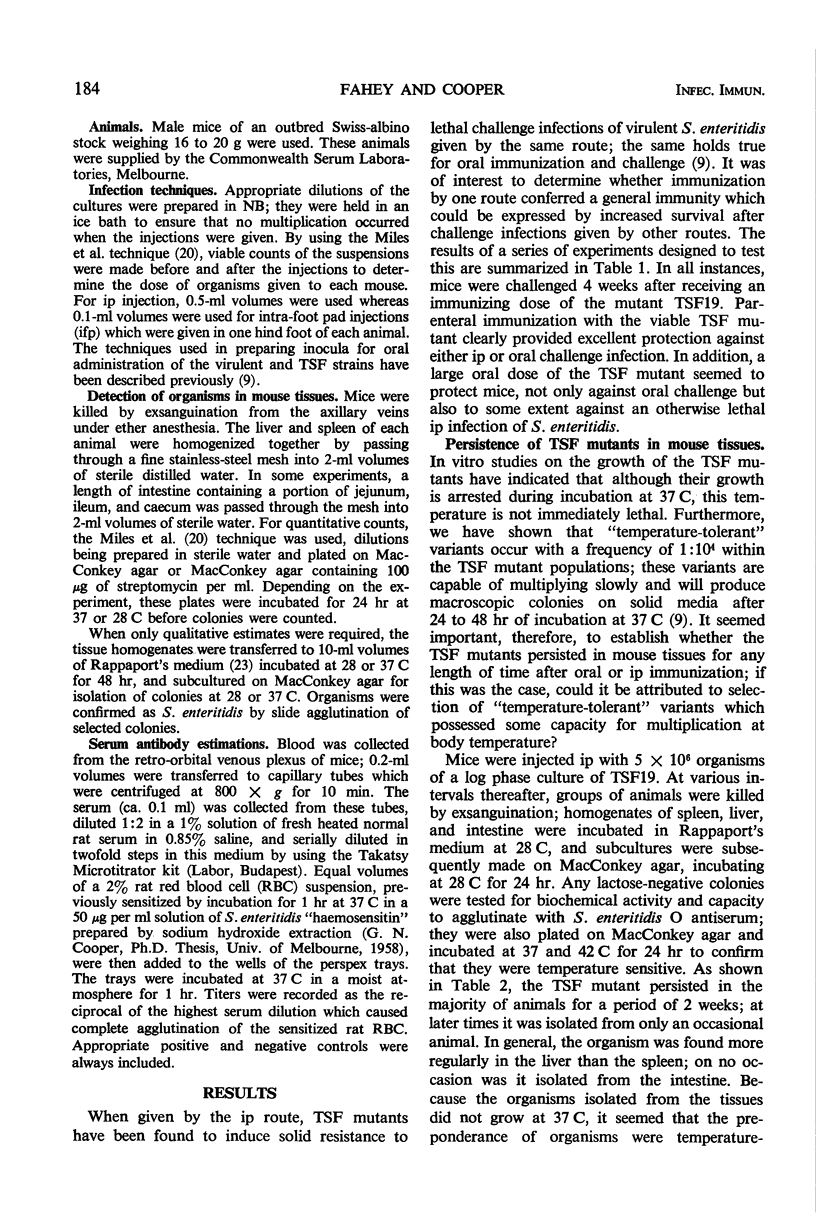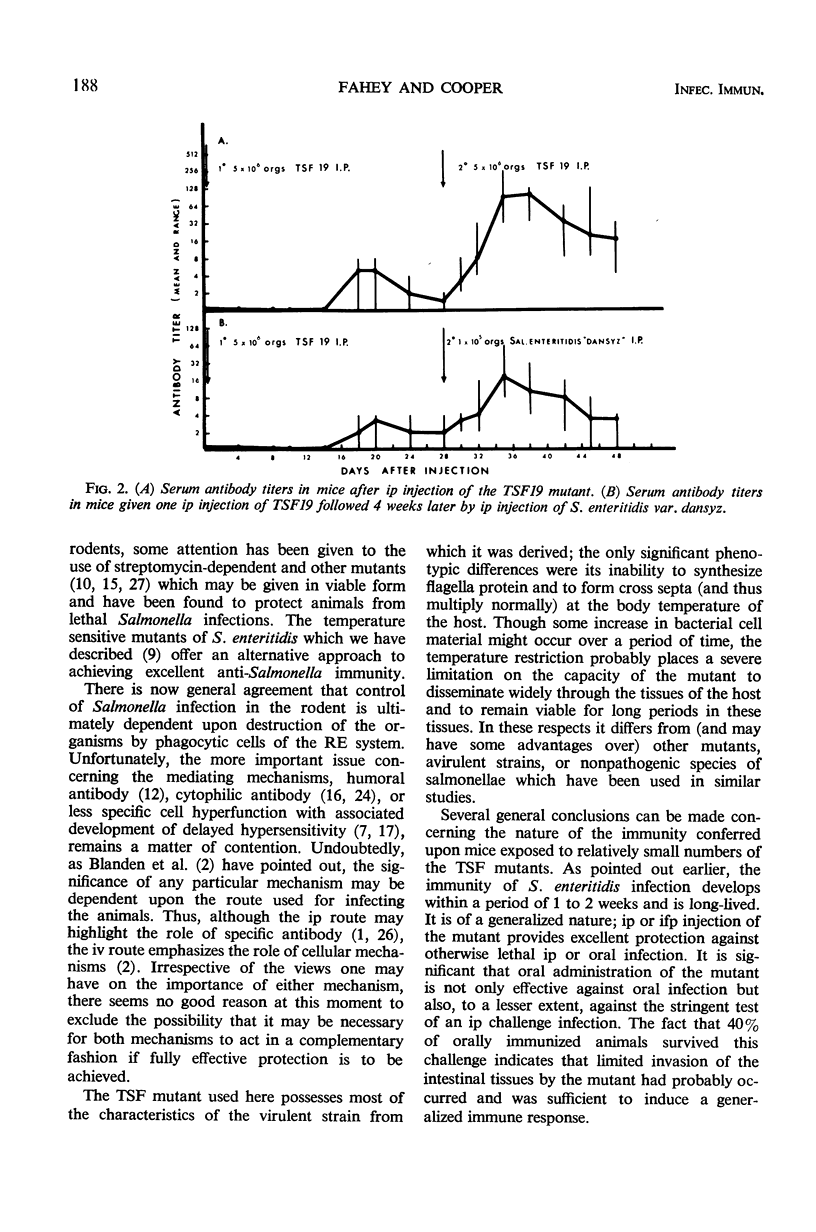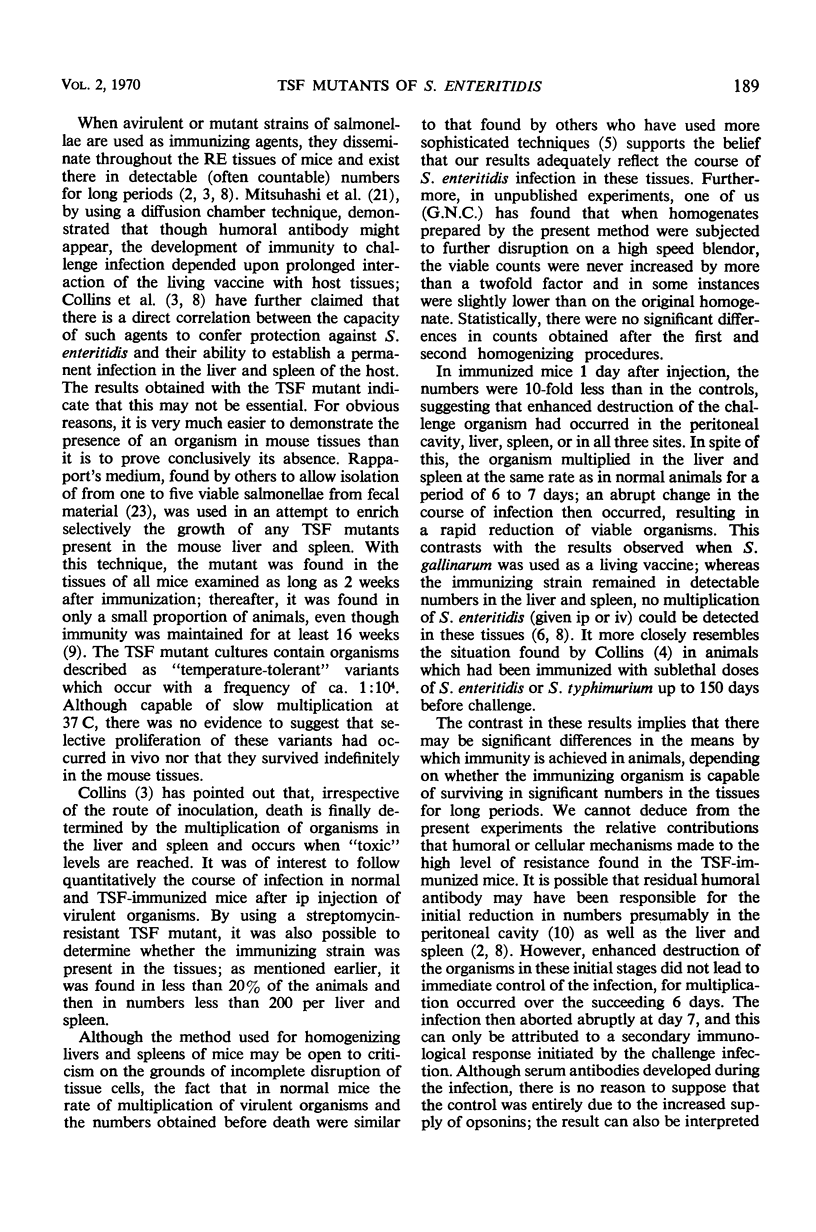Abstract
A temperature-sensitive mutant of Salmonella enteritidis, selected because of its inability to proliferate normally at 37 C, has been used as a living vaccine in mice. When given parenterally or orally, it confers a high degree of resistance against otherwise lethal S. enteritidis infections given intraperitoneally or by mouth. In contrast to most other effective living Salmonella vaccines, the temperature-sensitive mutant survives for only short periods in mouse tissues. Although the vaccine provides protection against S. typhimurium infection, possibly because of antigenic relationships between the immunizing and challenge organisms, it is ineffective against the intracellular infection caused by Listeria monocytogenes. A study of the kinetics of S. enteritidis infection in the liver and spleen of normal and immunized mice has suggested that immunity is dependent upon development of a secondary immunological response which arises approximately 7 days after introduction of the challenge infection. Although humoral antibody production forms part of this secondary response, it is not necessarily responsible for control of the infection.
Full text
PDF








Selected References
These references are in PubMed. This may not be the complete list of references from this article.
- AKIYAMA T., MAEDA K., USHIBA D. [Studies on immunity in experimental typhoid. Challenge of mice passively immunized with antiserum through various routes (mechanism of immunization with killed vaccines)]. Nihon Saikingaku Zasshi. 1962 Oct;17:829–834. [PubMed] [Google Scholar]
- Blanden R. V., Mackaness G. B., Collins F. M. Mechanisms of acquired resistance in mouse typhoid. J Exp Med. 1966 Oct 1;124(4):585–600. doi: 10.1084/jem.124.4.585. [DOI] [PMC free article] [PubMed] [Google Scholar]
- Collins F. M. Cross-protection against Salmonella enteritidis infection in mice. J Bacteriol. 1968 Apr;95(4):1343–1349. doi: 10.1128/jb.95.4.1343-1349.1968. [DOI] [PMC free article] [PubMed] [Google Scholar]
- Collins F. M. Effect of specific immune mouse serum on the growth of Salmonella enteritidis in mice preimmunized with living or ethyl alcohol-killed vaccines. J Bacteriol. 1969 Feb;97(2):676–683. doi: 10.1128/jb.97.2.676-683.1969. [DOI] [PMC free article] [PubMed] [Google Scholar]
- Collins F. M. Effect of specific immune mouse serum on the growth of Salmonella enteritidis in nonvaccinated mice challenged by various routes. J Bacteriol. 1969 Feb;97(2):667–675. doi: 10.1128/jb.97.2.667-675.1969. [DOI] [PMC free article] [PubMed] [Google Scholar]
- Collins F. M., Mackaness G. B., Blanden R. V. Infection-immunity in experimental salmonellosis. J Exp Med. 1966 Oct 1;124(4):601–619. doi: 10.1084/jem.124.4.601. [DOI] [PMC free article] [PubMed] [Google Scholar]
- Collins F. M., Mackaness G. B. Delayed hypersensitivity and arthus reactivity in relation to host resistance in salmonella-infected mice. J Immunol. 1968 Nov;101(5):830–845. [PubMed] [Google Scholar]
- Collins F. M. Recall of immunity in mice vaccinated with Salmonella enteritidis or Salmonella typhimurium. J Bacteriol. 1968 Jun;95(6):2014–2021. doi: 10.1128/jb.95.6.2014-2021.1968. [DOI] [PMC free article] [PubMed] [Google Scholar]
- Fahey K. J., Cooper G. N. Oral immunization against experimental salmonellosis I. Development of temperature-sensitive mutant vaccines. Infect Immun. 1970 Mar;1(3):263–270. doi: 10.1128/iai.1.3.263-270.1970. [DOI] [PMC free article] [PubMed] [Google Scholar]
- HOWARD J. G. Resistance to infection with Salmonella paratyphi C in mice parasitized with a relatively avirulent strain of Salmonella typhimurium. Nature. 1961 Jul 1;191:87–88. doi: 10.1038/191087a0. [DOI] [PubMed] [Google Scholar]
- JENKIN C. R., ROWLEY D. BASIS FOR IMMUNITY TO TYPHOID IN MICE AND THE QUESTION OF "CELLULAR IMMUNITY". Bacteriol Rev. 1963 Dec;27:391–404. doi: 10.1128/br.27.4.391-404.1963. [DOI] [PMC free article] [PubMed] [Google Scholar]
- JENKIN C. R., ROWLEY D. PARTIAL PURIFICATION OF THE "PROTECTIVE" ANTIGEN OF SALMONELLA TYPHIMURIUM AND ITS DISTRIBUTION AMONGST VARIOUS STRAINS OF BACTERIA. Aust J Exp Biol Med Sci. 1965 Feb;43:65–78. doi: 10.1038/icb.1965.5. [DOI] [PubMed] [Google Scholar]
- JENKIN C. R. The effect of opsonins on the intracellular survival of bacteria. Br J Exp Pathol. 1963 Feb;44:47–57. [PMC free article] [PubMed] [Google Scholar]
- Jenkin C. R., Karnovsky M. L., Rowley D. Preparation of an artificial antigen and immunity to mouse typhoid. Immunology. 1967 Oct;13(4):361–372. [PMC free article] [PubMed] [Google Scholar]
- KISHIMOTO Y. [LIVE VACCINE IMMUNIZATION IN EXPERIMENTAL TYPHOID WITH A STREPTOMYCIN DEPENDENT STRAIN OF SALMONELLA ENTERITIDIS]. Nihon Saikingaku Zasshi. 1965 Apr;20:195–202. doi: 10.3412/jsb.20.195. [DOI] [PubMed] [Google Scholar]
- KONFORTI N., NAVON B., RAPPAPORT F. A new enrichment medium for certain Salmonellae. J Clin Pathol. 1956 Aug;9(3):261–266. doi: 10.1136/jcp.9.3.261. [DOI] [PMC free article] [PubMed] [Google Scholar]
- Kurashige S., Osawa N., Kawakami M., Mitsuhashi S. Experimental salmonellosis. X. Cellular immunity and its antibody in mouse mononuclear phagocytes. J Bacteriol. 1967 Oct;94(4):902–906. doi: 10.1128/jb.94.4.902-906.1967. [DOI] [PMC free article] [PubMed] [Google Scholar]
- MACKANESS G. B. THE IMMUNOLOGICAL BASIS OF ACQUIRED CELLULAR RESISTANCE. J Exp Med. 1964 Jul 1;120:105–120. doi: 10.1084/jem.120.1.105. [DOI] [PMC free article] [PubMed] [Google Scholar]
- Mackaness G. B., Blanden R. V., Collins F. M. Host-parasite relations in mouse typhoid. J Exp Med. 1966 Oct 1;124(4):573–583. doi: 10.1084/jem.124.4.573. [DOI] [PMC free article] [PubMed] [Google Scholar]
- Mackaness G. B. The relationship of delayed hypersensitivity to acquired cellular resistance. Br Med Bull. 1967 Jan;23(1):52–54. doi: 10.1093/oxfordjournals.bmb.a070516. [DOI] [PubMed] [Google Scholar]
- Mitsuhashi S., Osawa N., Saito K., Kurashige S. Cellular immunity with special reference to monocytes of mice immunized with live vaccine of Salmonella enteritidis. Tohoku J Exp Med. 1966 Aug 25;89(4):307–314. doi: 10.1620/tjem.89.307. [DOI] [PubMed] [Google Scholar]
- ROWLEY D., TURNER K. J., JENKIN C. R. THE BASIS FOR IMMUNITY TO MOUSE TYPHOID. 3. CELL-BOUND ANTIBODY. Aust J Exp Biol Med Sci. 1964 Apr;42:237–248. doi: 10.1038/icb.1964.25. [DOI] [PubMed] [Google Scholar]
- SAITO K., AKIYAMA T., NAKANO M., USHBA D. Interaction between Salmonella enteritidis and tissue cultured macrophages derived from immunized animals. Jpn J Microbiol. 1960 Oct;4:395–407. doi: 10.1111/j.1348-0421.1960.tb00188.x. [DOI] [PubMed] [Google Scholar]
- USHIBA D., SAITO K., AKIYAMA T., NAKANO M., SUGIYAMA T., SHIRONO S. Studies on experimental typhoid: bacterial multiplication and host cell response after infection with Salmonella enteritidis in mice immunized with live and killed vaccines. Jpn J Microbiol. 1959 Apr;3:231–242. doi: 10.1111/j.1348-0421.1959.tb00119.x. [DOI] [PubMed] [Google Scholar]


